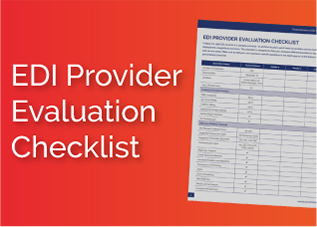Meet Your Efficiency Goals Faster: How Supply Chain Managers Can Leverage Integrated EDI to Boost Productivity, Cut Costs, and Scale Operations

March 30, 2023
According to the National Association of Manufacturers Industry Outlook Survey, 65% of business leaders say supply chain challenges are the number-one challenge for their companies. When you consider the compounding issues of a looming recession, supply shortages, and labor constraints, it’s no surprise that more efficient supply chain processes are at the forefront of business priorities.
Often, when we talk about supply chain issues, we focus on industries and brands. But what about the people who are held responsible for supply chain optimization within those areas? For directors and managers of IT, operations, production, purchasing, inventory, logistics, etc., managing the supply chain has become harder than ever. What’s more, because of the impact these activities have on a company’s bottom line, executive expectations aren’t lowering.
To better understand the needs and goals of the people truly powering the supply chain, we took a look at real job listings for supply chain management positions. We explored the different “asks” made by companies when it comes to automation, optimization, and efficiency. And then we dove into those priorities to offer concrete actions you can implement at your own business to hit those goals more quickly.
Common Goals for Supply Chain Teams
Optimization and efficiency were running themes in the job listings’ responsibilities section. Incoming managers are expected to assess and analyze existing performance. Once they do, they need to find ways to improve that performance—while cutting costs of course.
Here were some of the top goals we saw, each paired with an action item to help you achieve them.
Streamlining the Supply Chain
“Drive cost savings improving manufacturability of products, creating economies of scale and optimizing supply-chains.”
“Assessing and enhancing the efficiency of internal and external operational processes.”
Lower costs while increasing productivity. Not an easy request for a Senior Sourcing Engineer or a Director of Operations. But since logistics and raw materials costs keep going up, finding areas to save is critical for any supply chain team. Scalability is also top of mind for businesses that want to take advantage of omnichannel consumption and keep a competitive edge as they grow.
One way to achieve both is to implement integrated electronic data interchange (EDI). Integrated EDI lowers costs by eliminating tedious manual data entry to and from your ERP. Not only does that save time; it allows an Ops Director or Sourcing leader to reallocate personnel and increase efficiencies in other areas. Because integrated EDI delivers data directly to your ERP, it also prevents data errors, and can allow you to process and respond to orders much more quickly.
Integrated EDI that’s built in the cloud also supports scalability. Its ability to process huge volumes of data in minutes means that your brand can meet spikes in demand more easily. And while an on-premises solution would require additional servers as you grow, a cloud-based EDI solution can process any number of orders with the same level of efficiency.
Pro tip: Even if your company already has EDI, it’s always good to look at the solution and see if it’s still meeting your needs. Proprietary or on-premises solutions can take a lot of time and effort to manage and may not be scalable. Some cloud solutions offer software without support, putting the burden on you to manage compliance, trading partner onboarding, and issue resolution. To ensure your business is getting the most bang for its buck, consider if it might be time for a new EDI solution.
Managing Inventory Levels
“Manage and maintain inventory controls for all materials, ensuring a level delivery plan that supports production plans while managing inventory level expectations”
This goal was for a Supply Chain Manager at a manufacturing company. Ideally, the employer is looking for a manager who can ensure there’s enough on-hand materials to prevent any production pauses. At the same time, they want to avoid overstocks, which cost money to store and could end up in the trash if demand doesn’t meet supply.
Achieving that balance requires flexible, yet accurate forecasting and proactive procurement strategies. One way to do so is to leverage vendor managed inventory software. A VMI solution would enable the manufacturer to collect real-time sales and forecasting data from its buyers. The system then combines the data with preset inventory goals and uses machine learning to create recommendations for orders. The Supply Chain Manager can not only save time on forecasting, but also make strategic materials purchasing decisions based on current market demand to ensure a balanced inventory.
Managing Supplier Relationships
“Manage assigned and establish new supplier relationships to ensure sufficient communication and alignment between the suppliers and [Company].”
The new Sourcing Lead for this company will need to manage supplier relationships, which could involve back-and-forth communication on orders, assessing supplier performance, and addressing any issues suppliers may face in meeting critical SLAs. But unless the company already mandates EDI, it’s likely their suppliers are using a variety of communication methods. This can make a Sourcing Lead’s job very difficult.
One fix is to mandate EDI among all suppliers. But if the company uses a lot of SMB suppliers, some suppliers may not be ready to, or be able to afford a full EDI solution. So, another option is to implement a supplier enablement platform. This software offers suppliers multiple ways to enter order information. It can ingest EDI documents, PDFs, or emails, and features a lighter web-EDI portal as well. The data is then transformed into an ERP-friendly format and delivered right to the ERP itself.
For a Sourcing Lead, that can cut out tons of time spent tracking down emails, making phone calls and manually keying data into internal systems. Even better, supplier enablement software often features performance analytics, which can track important KPIs like on-time, in-full rates. Having this data on-hand can help a Sourcing Lead keep everyone “aligned,” and pinpoint areas of improvement quickly.
Ensuring Customer Satisfaction
“Oversee and manage the overall supply chain and logistics strategy in order to maximize the process efficiency and productivity to support on time delivery to our customers.”
Another goal for our Supply Chain Manager—and really, for anyone who works in the supply chain—is customer satisfaction. Today, customer satisfaction relies on timely delivery, but also on an excellent purchasing experience from the start.
What makes an excellent buying experience? It could be:
- Accurate inventory availability across channels
- Rapid responses to new orders
- Quick turnaround and communication of shipping times
Again, investing in EDI can help a Supply Chain Manager achieve these goals. For example, EDI 846 Inventory Inquiry/Advice documents can be used to update partners and channels on current stock numbers. EDI 855 Purchase Order Acknowledgements let a customer know that their order has been received and accepted, and EDI 856 Advance Shipping Notices include shipping details including expected delivery date and tracking information. Automating these via integrated EDI hastens communication to keep customers in the loop, which can boost their confidence and happiness.
Vaillant’s Story
How do we know these solutions can help? Because we’ve seen it.
For The Vaillant Group, EDI wasn’t new. They had an on-premises, integrated solution that had already helped save time on manual processes. But it wasn’t scalable, which meant it was holding the brand’s growth back. According to Vaillant’s eCommerce Trading Manager, “we continually look for ways to improve the efficiency of our systems and processes. As our customers’ EDI requirements continued to grow, managing them became more complex and required increasing amounts of internal resources.”
“To ensure that we had a solution that would support future growth and enable us to continue delivering the highest level of service to our customers, something which is synonymous with the Vaillant brand, the decision was made to move to a specialist, outsourced EDI provider.”
And support future growth it did! The TrueCommerce solution plugged directly into Vaillant’s SAP ERP system, while the TrueCommerce team took over day-to-day EDI management to reduce the burden on the Vaillant team. The brand can now exchange orders, invoices, acknowledgements and ASNs daily, and just moments after incoming documents are received. Plus, without on-premises hardware to manage or software to maintain, Vaillant has augmented its new scalability with increased cost savings.
Convincing Leadership to Invest in Technology
The same leaders hiring you with these goals in mind may still be the hardest to convince when it comes to purchasing new supply chain technology. A lot of that comes down to the effects of a possible recession, which can make leaders more fiscally conservative. Some executives might also worry about the disruption of switching to a new EDI solution, or implementing a supplier enablement platform that requires supplier onboarding.

To overcome their hesitation, you need to be able to show both the short- and long-term ROI of each project. You can do so by presenting case studies, pointing out the costs of delaying an investment, and if possible, pulling from your own experience. Choosing a vendor that can minimize disruption and handle things like compliance testing, as well as customer and supplier onboarding can also bolster your proposal.
To make sure you’re selecting the right vendor, check out our EDI Buyer’s Guide and Vendor Comparison Checklist.
You Can Reach Your Supply Chain Goals
Often, when we talk about EDI, VMI, and other supply chain technologies, we look at them as ways for businesses to gain a competitive advantage. We talk about connecting with partners, expanding globally, and finding new channels. But just as critical are the impact these technologies have on internal processes and the team managing your supply chain every day.
When you invest in integrated solutions like EDI, you can create real change in the day-to-day or your teammates while meeting company-wide objectives. You can cut costs, increase productivity, scale sales, and keep customers happy, and prove to leadership that you were the perfect hire.
To learn more about EDI, VMI, and supplier enablement solutions from TrueCommerce, contact us today!
Share this post:
Categories
Stay ahead of the competition
Get expert supply chain insights delivered directly to your inbox weekly.
